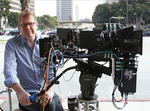Is Creating Ads For 3D Technology Worth It?
This guest article is written by James Stewart who is a director at Geneva Film Co. in Toronto. When not directing "flatties" he's knee deep in the next dimension of advertising.
To 3D or not to 3D? That is the question. Agencies and brands alike continue to second-guess this ever-growing technology as though it was the new Betamax of the digital age. Is it really worth the production complexity and added expense? Will a large enough audience stand in awe of your creation's visual splendor to make it worth your while? The answer is quickly becoming a resounding 'YES'.
Let's face it, 3D is no longer an experience reserved solely for the latest state of the art cinemas. Digital 3D is everywhere. Flat-screen TV's, laptops, tablets, even smartphones like HTC's Evo 3D and LG's 3D Thrill are taking the 3D experience out of the theatre and putting it in the palm of your hand. And, with the advent of autostereoscopic technology (read: glasses-free), gone are the clunky Orbison-like lenses allowing instead for beautiful, full-color, hyper-crisp 3D to be viewed with the naked eye.
Like the HD revolution that preceded it, once 3D technology enters the home, a "Build it, and they will come..." axiom will come to bear. ESPN, Sky and Discovery/Imax already boast 24/7 3D programming options. High profile acts like Black-Eyed Peas, U2 and Cirque du Soleil (and soon Katy Perry as well!) are delivering the goods in front of 3D cameras. The masters of cinema like Spielberg, Coppola, Jackson, Wim Wenders and Scorcese all have 3D films in production or release. In fact, Scorcese's 3D epic Hugo just topped this year's Oscar list with 11 nominations. Gamers are now enjoying 3D versions of franchise titles like Call Of Duty and Gran Turismo on Sony's PS3 console, not to mention the tens of millions of people worldwide feasting on Nintendo's 3DS, a glasses-free 3D portable device. No matter where you look, 3D is finding its way into the digital streams that flow through our daily lives. What the 3D revolution needs now, more than anything, is content.
As founder of the Geneva Film Co. in Toronto, I've produced and directed 3D projects all over the world. I've personally seen 3D come of age making leaps and bounds in some arenas like feature film, and sadly, much more slowly in others such as advertising. Yet, each year I am thrilled to see the production volume increasing, as 3D transcends its "gimmicky" moniker and agencies begin to take advantage of the unique, immersive possibilities that 3D offers our medium. Household names like Sony, Pepsi, Coke, Lexus, Toyota, and Sprint are already blazing the trail as pioneers of digital 3D marketing. Despite all this, hesitation is still a common sentiment among smaller agencies.
For those of you who may still doubt 3D's relevance, consider this: in studies from multiple independent sources - including ESPN, Xpand, and Texas Instruments, 3D spots have proven to have an average viewer retention increase of 15% versus their 2D counterparts. For a nominal increase in production cost, you can gain 15 to 20% in ad recall. What agency doesn't want to offer their client that kind of impact? Given the increasing popularity and acceptance of the 3D medium, and the ever-growing list of personal technologies that can deliver 3D to your target audience, I'm reminded of what hockey great Wayne Gretzky used to say: "A good hockey player plays where the puck is. A GREAT hockey player plays where the puck is going to be."
James Stewart is a director at Geneva Film Co. in Toronto. When not directing "flatties" he in deep in the next dimension of advertising.


